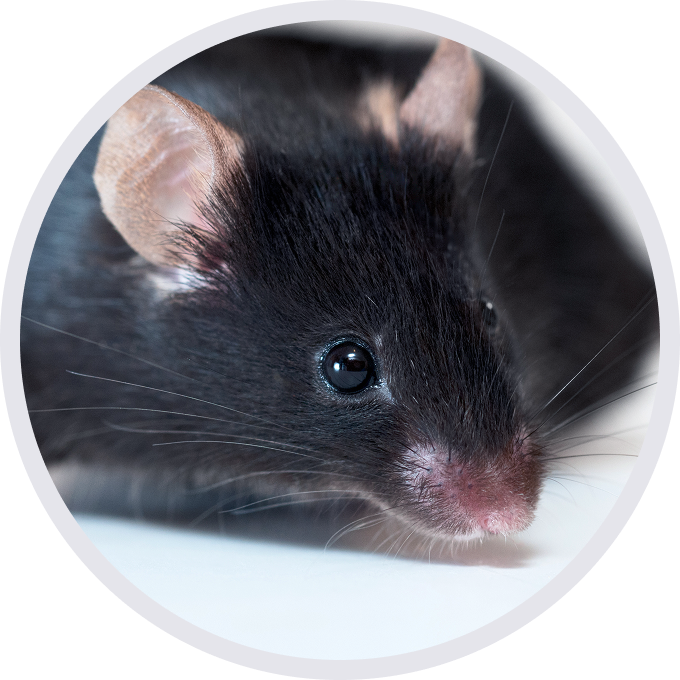
C57BL/6-Tnfsf15tm2(TNFSF15)Bcgen Tnfrsf25tm3(TNFRSF25)Bcgen Itga4tm1(ITGA4)Bcgen Itgb7tm1(ITGB7)Bcgen/Bcgen • 113885

| Product name | B-hTL1A/hDR3/hα4β7 mice |
|---|---|
| Catalog number | 113885 |
| Strain name | C57BL/6-Tnfsf15tm2(TNFSF15)Bcgen Tnfrsf25tm3(TNFRSF25)Bcgen Itga4tm1(ITGA4)Bcgen Itgb7tm1(ITGB7)Bcgen/Bcgen |
| Strain background | C57BL/6 |
| NCBI gene ID | 3676,3695,8718,9966 (Human) |
| Aliases | APO-3; DDR3; DR3; GEF720; LARD; PLEKHG5; TNFRSF12; TR3; TRAMP; WSL-1; WSL-LR; CD49D; IA4; TL1; TL1A; TNLG1B; VEGI; VEGI192A; VEGI192A; APO-3; WSL-LR; CD49D; IA4; |
Gene targeting strategy for B-hTL1A/hDR3/hα4β7 mice
The exons 1-4 of mouse Tl1a gene that encode extracellular domain were replaced by human counterparts in B-hTL1A/hDR3/hα4β7 mice. The genomic region of mouse Tl1a gene that encodes transmembrane domain and cytoplasmic portion was retained. The promoter, 5’UTR and 3’UTR region of the mouse gene were also retained. The human TL1A expression was driven by endogenous mouse Tl1a promoter, while mouse Tl1a gene transcription and translation will be disrupted.
The exons 1-10 of mouse DR3 gene that encode the whole molecule (ATG to STOP codon), including promoter, 5’UTR and 3’UTR were replaced by human counterparts in B-hTL1A/hDR3/hα4β7 mice. The human DR3 expression was driven by human DR3 promoter, while mouse DR3 gene transcription and translation will be disrupted.
The exons 2-27 of mouse Itga4 gene that encode the extracellular domain were replaced by human counterparts in B-hTL1A/hDR3/hα4β7 mice. The promoter, 5’UTR and 3’UTR region of the mouse gene were retained. The human ITGA4 expression was driven by endogenous mouse Itga4 promoter, while mouse Itga4 gene transcription and translation will be disrupted.
The exons 2-14 of mouse Itgb7 gene that encode the extracellular domain were replaced by human counterparts in B-hTL1A/hDR3/hα4β7 mice. The promoter, 5’UTR and 3’UTR region of the mouse gene were retained. The human ITGB7 expression was driven by endogenous mouse Itgb7 promoter, while mouse Itgb7 gene transcription and translation will be disrupted.
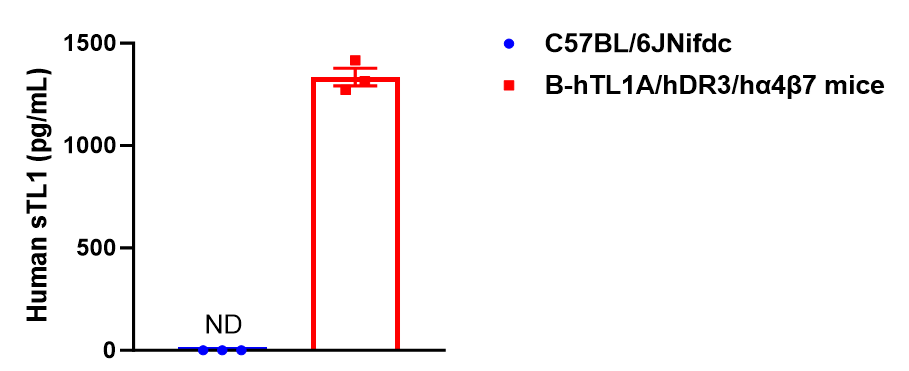
Strain specific TL1 expression analysis in homozygous B-hTL1A/hDR3/hα4β7 mice by ELISA. Bone marrow-derived dendritic cells were isolated from wild-type C57BL/6JNifdc mice (+/+) and homozygous B-hTL1A/hDR3/hα4β7 mice (H/H;H/H;H/H;H/H) (male, 6-week-old, n=3), and stimulated with 1 μg/mL LPS in vitro for 24 h, then cell supernatants were collected and analyzed by ELISA (anti-human TL1 ELISA kit: R&D, DY1319-05). Human TL1 was exclusively detectable in homozygous B-hTL1A/hDR3/hα4β7 mice but not in wild-type mice. ND: not detectable.
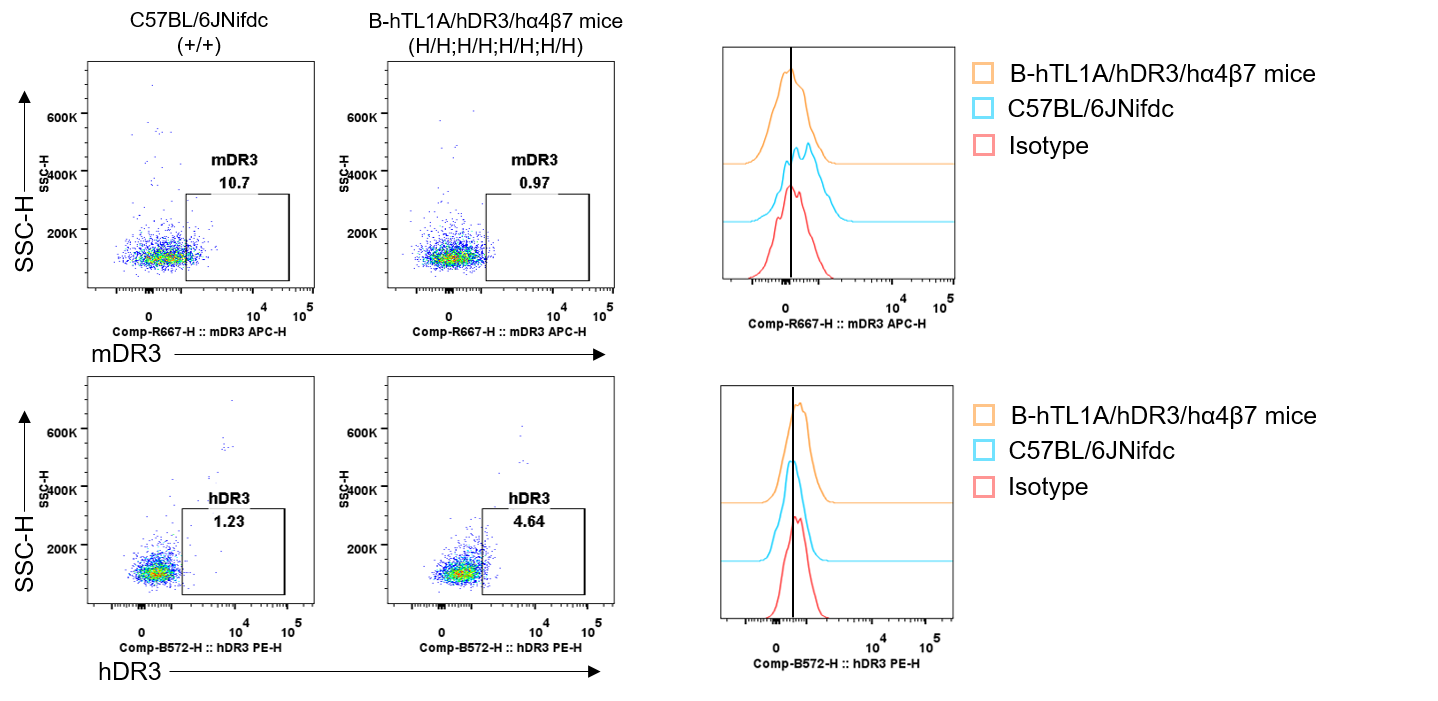
Strain specific DR3 expression analysis in wild-type C57BL/6JNifdc mice and homozygous B-hTL1A/hDR3/hα4β7 mice by flow cytometry. Splenocytes were collected from wild-type C57BL/6JNifdc mice (+/+) and homozygous B-hTL1A/hDR3/hα4β7 mice (H/H;H/H;H/H;H/H), protein expression was analyzed with anti-mouse DR3 antibody (Biolegend, 144407) and anti-human DR3 antibody (Biolegend, 307105) by flow cytometry. Mouse DR3 was detectable on Treg cells of wild-type C57BL/6JNifdc mice, human DR3 was detectable on Treg cells of homozygous B-hTL1A/hDR3/hα4β7 mice.

Strain specific DR3 expression analysis in in wild-type C57BL/6JNifdc mice and homozygous B-hTL1A/hDR3/hα4β7 mice by flow cytometry. Splenocytes were collected from wild-type C57BL/6JNifdc mice (+/+) and homozygous B-hTL1A/hDR3/hα4β7 mice (H/H;H/H;H/H;H/H), and analyzed by flow cytometry with anti-human DR3 antibody Ab1, which is offered by the client. Ab1 binding were only detected on Treg cells of homozygous B-hTL1A/hDR3/hα4β7 mice .
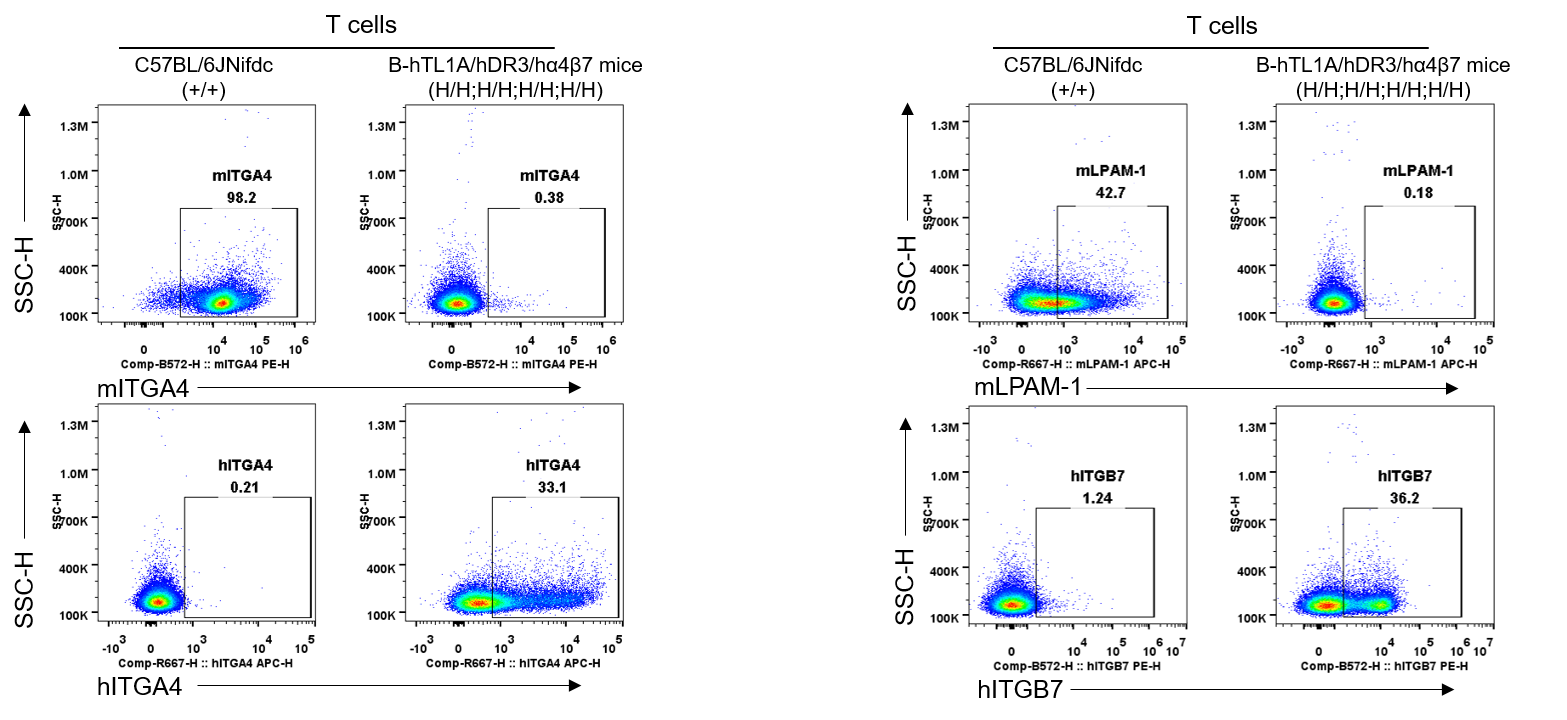
Strain specific ITGA4 and ITGB7 expression analysis in wild-type C57BL/6JNifdc mice and homozygous humanized B-hTL1A/hDR3/hα4β7 mice by flow cytometry. Splenocytes were collected from wild-type C57BL/6JNifdc mice (+/+) and homozygous B-hTL1A/hDR3/hα4β7 mice (H/H;H/H;H/H;H/H). Protein expression was analyzed with anti-mouse ITGA4 antibody (Biolegend, 103705), anti-mouse LPAM-1/α4β7 antibody (Biolegend, 120607), anti-human ITGA4 antibody (Biolegend, 304307) anti-human ITGB7 antibody (Invitrogen, MA5-23541) by flow cytometry. Mouse ITGA4 and ITGB7 were only detectable in wild-type C57BL/6JNifdc mice. Human ITGA4 and ITGB7 were exclusively detectable in homozygous B-hTL1A/hDR3/hα4β7 mice, but not in wild-type C57BL/6JNifdc mice.
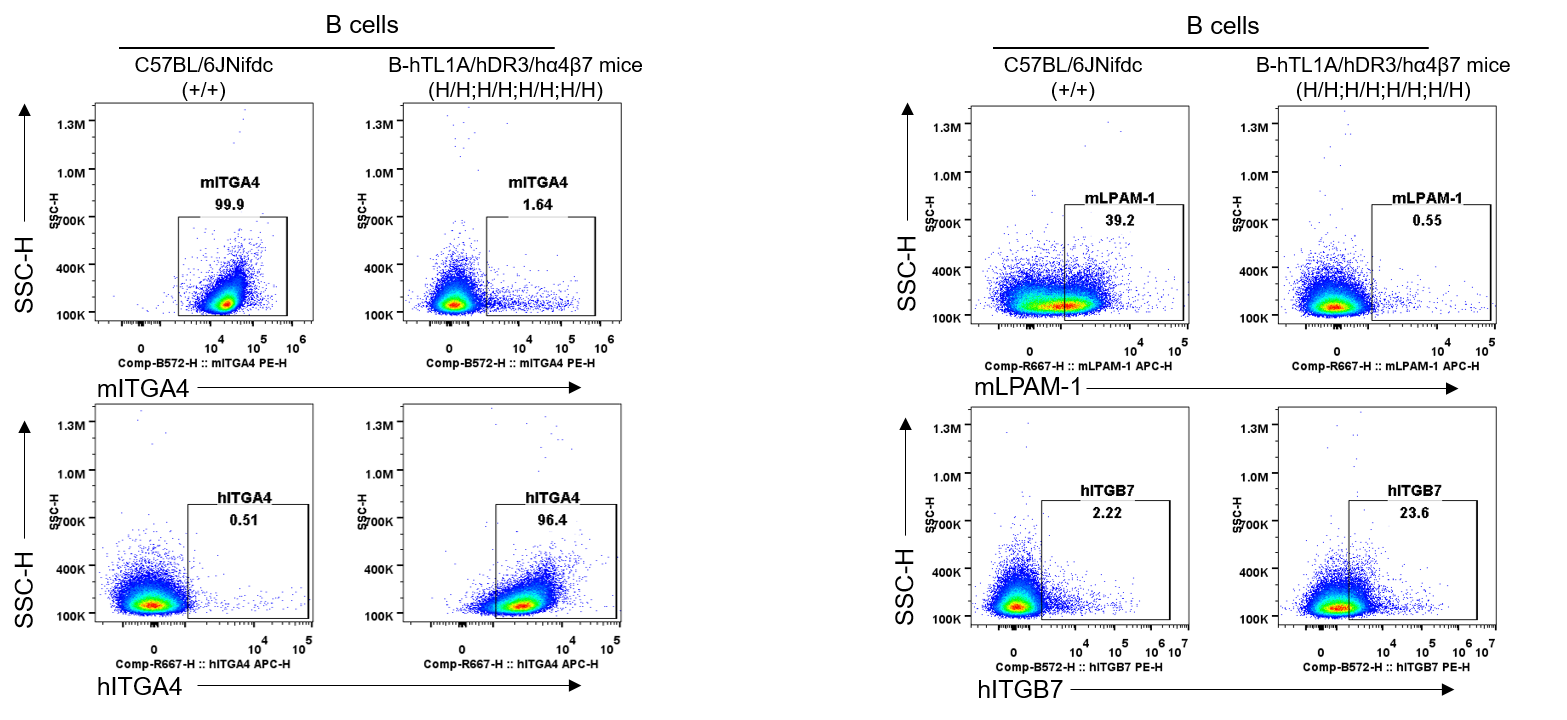
Strain specific ITGA4 and ITGB7 expression analysis in wild-type C57BL/6JNifdc mice and homozygous humanized B-hTL1A/hDR3/hα4β7 mice by flow cytometry. Splenocytes were collected from wild-type C57BL/6JNifdc mice (+/+) and homozygous B-hTL1A/hDR3/hα4β7 mice (H/H;H/H;H/H;H/H). Protein expression was analyzed with anti-mouse ITGA4 antibody (Biolegend, 103705), anti-mouse LPAM-1/α4β7 antibody (Biolegend, 120607), anti-human ITGA4 antibody (Biolegend, 304307) anti-human ITGB7 antibody (Invitrogen, MA5-23541) by flow cytometry. Mouse ITGA4 and ITGB7 were only detectable in wild-type C57BL/6JNifdc mice. Human ITGA4 and ITGB7 were exclusively detectable in homozygous B-hTL1A/hDR3/hα4β7 mice, but not in wild-type C57BL/6JNifdc mice.
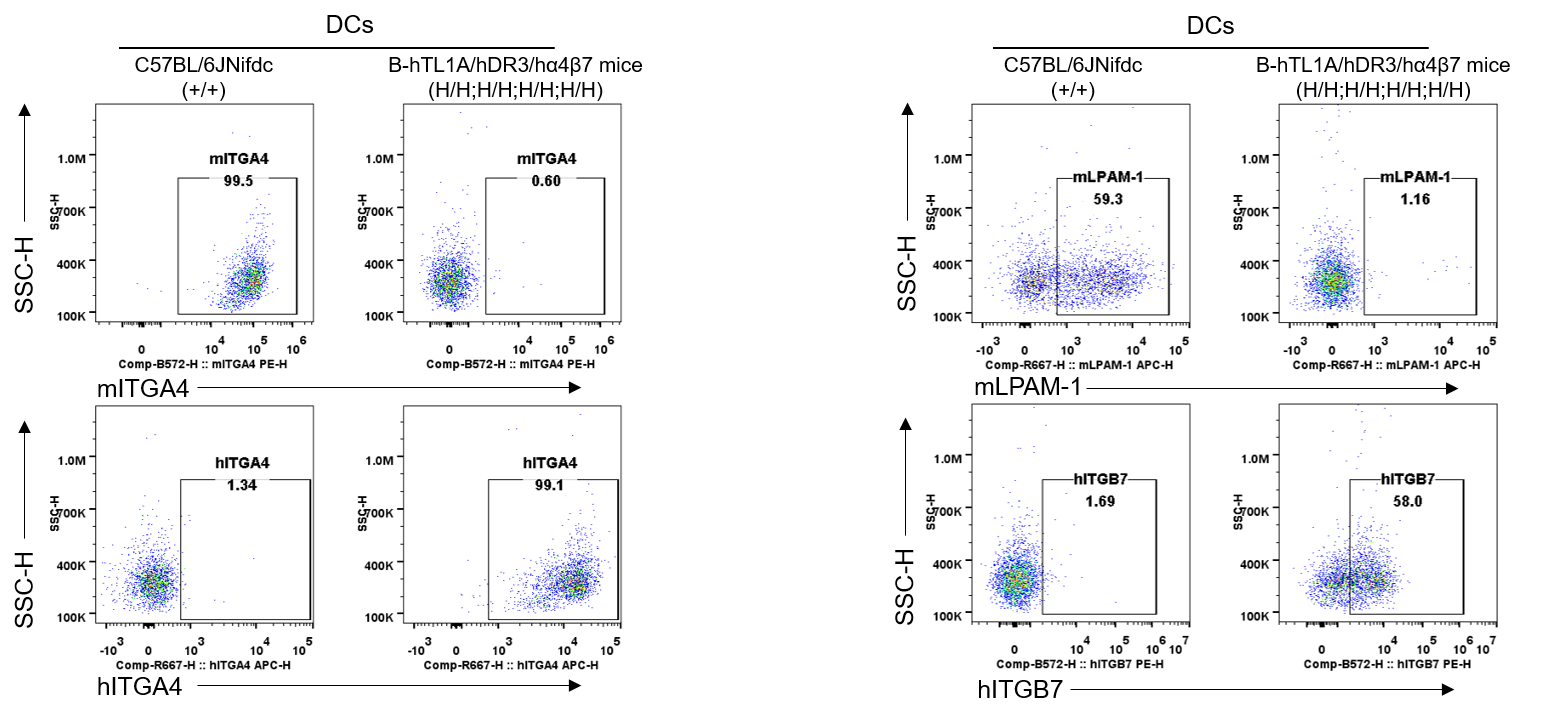
Strain specific ITGA4 and ITGB7 expression analysis in wild-type C57BL/6JNifdc mice and homozygous humanized B-hTL1A/hDR3/hα4β7 mice by flow cytometry. Splenocytes were collected from wild-type C57BL/6JNifdc mice (+/+) and homozygous B-hTL1A/hDR3/hα4β7 mice (H/H;H/H;H/H;H/H). Protein expression was analyzed with anti-mouse ITGA4 antibody (Biolegend, 103705), anti-mouse LPAM-1/α4β7 antibody (Biolegend, 120607), anti-human ITGA4 antibody (Biolegend, 304307) anti-human ITGB7 antibody (Invitrogen, MA5-23541) by flow cytometry. Mouse ITGA4 and ITGB7 were only detectable in wild-type C57BL/6JNifdc mice. Human ITGA4 and ITGB7 were exclusively detectable in homozygous B-hTL1A/hDR3/hα4β7 mice, but not in wild-type C57BL/6JNifdc mice.
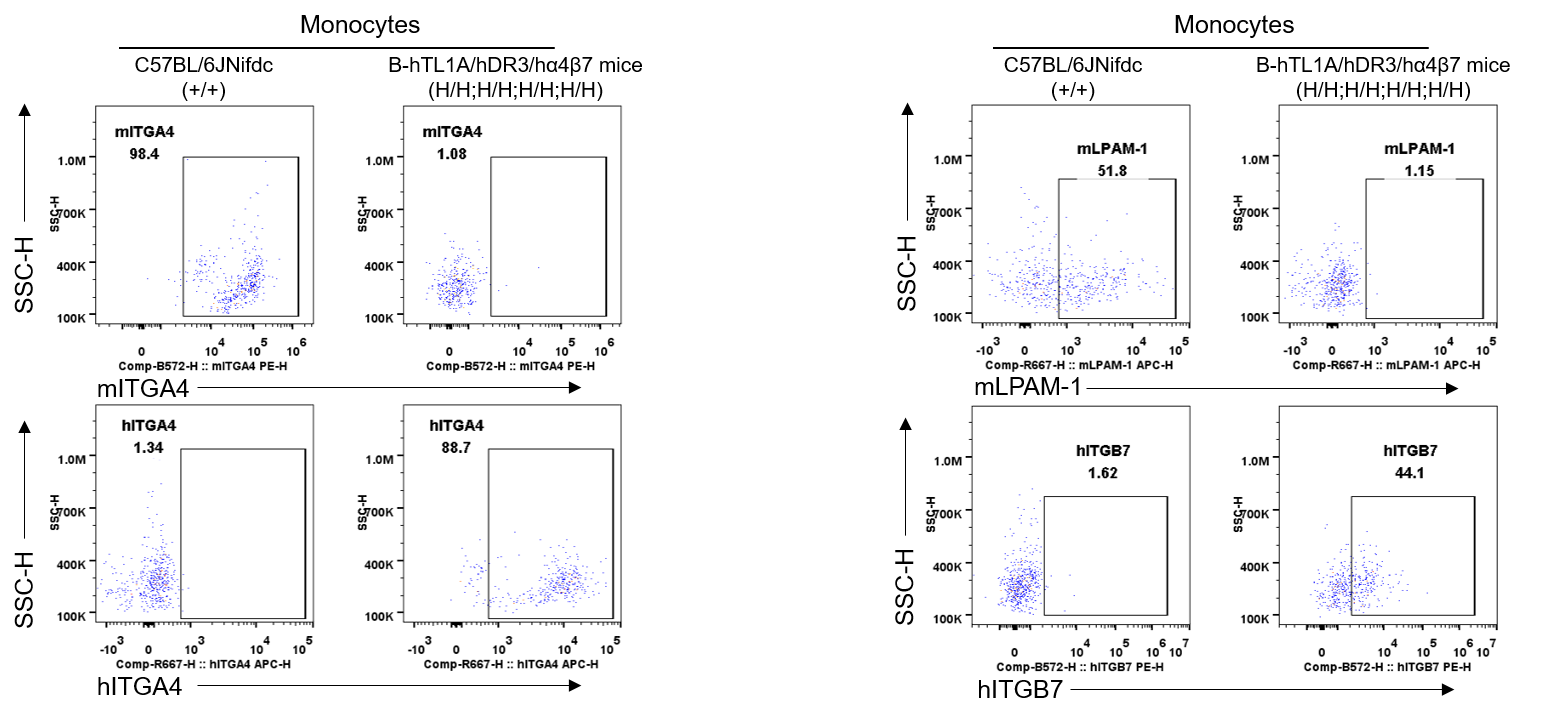
Strain specific ITGA4 and ITGB7 expression analysis in wild-type C57BL/6JNifdc mice and homozygous humanized B-hTL1A/hDR3/hα4β7 mice by flow cytometry. Splenocytes were collected from wild-type C57BL/6JNifdc mice (+/+) and homozygous B-hTL1A/hDR3/hα4β7 mice (H/H;H/H;H/H;H/H). Protein expression was analyzed with anti-mouse ITGA4 antibody (Biolegend, 103705), anti-mouse LPAM-1/α4β7 antibody (Biolegend, 120607), anti-human ITGA4 antibody (Biolegend, 304307) anti-human ITGB7 antibody (Invitrogen, MA5-23541) by flow cytometry. Mouse ITGA4 and ITGB7 were only detectable in wild-type C57BL/6JNifdc mice. Human ITGA4 and ITGB7 were exclusively detectable in homozygous B-hTL1A/hDR3/hα4β7 mice, but not in wild-type C57BL/6JNifdc mice.
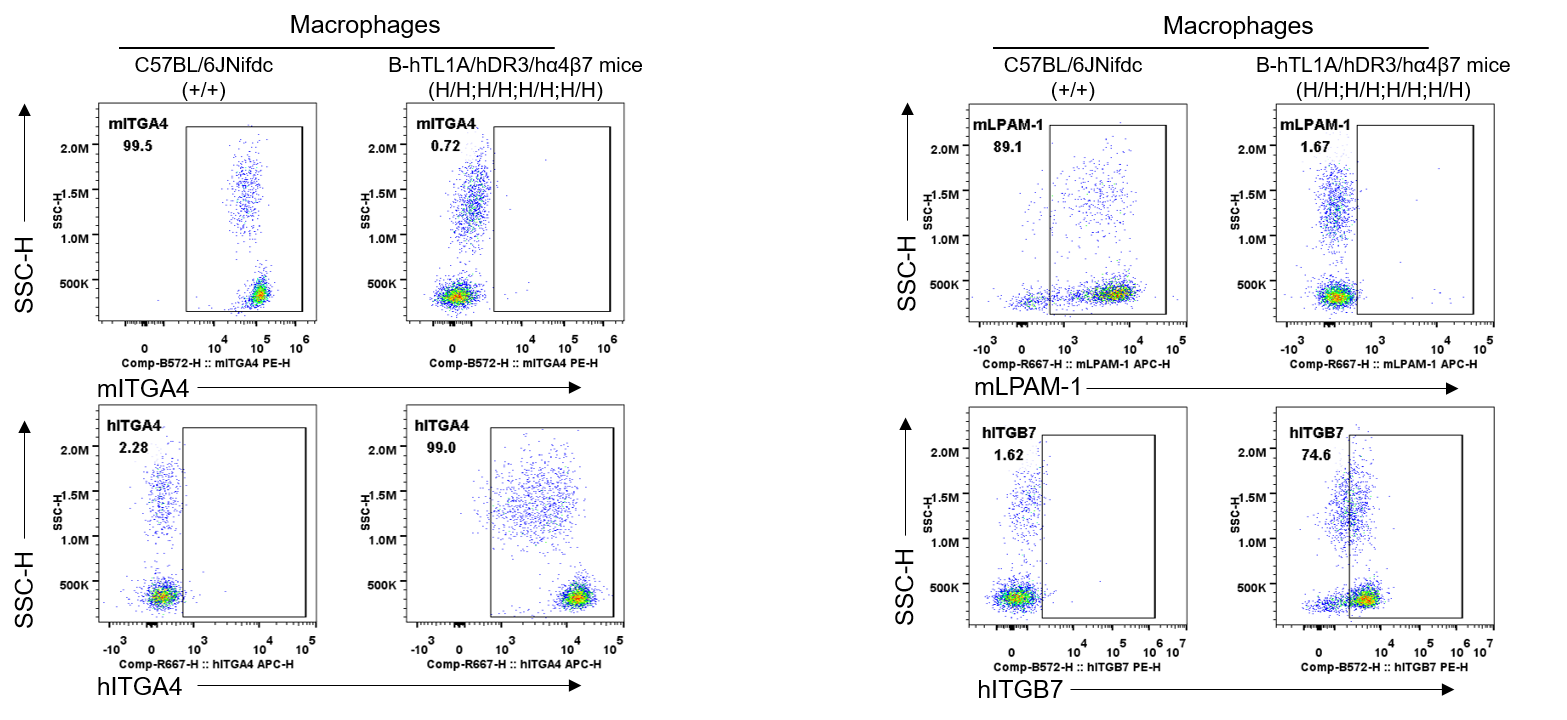
Strain specific ITGA4 and ITGB7 expression analysis in wild-type C57BL/6JNifdc mice and homozygous humanized B-hTL1A/hDR3/hα4β7 mice by flow cytometry. Splenocytes were collected from wild-type C57BL/6JNifdc mice (+/+) and homozygous B-hTL1A/hDR3/hα4β7 mice (H/H;H/H;H/H;H/H). Protein expression was analyzed with anti-mouse ITGA4 antibody (Biolegend, 103705), anti-mouse LPAM-1/α4β7 antibody (Biolegend, 120607), anti-human ITGA4 antibody (Biolegend, 304307) anti-human ITGB7 antibody (Invitrogen, MA5-23541) by flow cytometry. Mouse ITGA4 and ITGB7 were only detectable in wild-type C57BL/6JNifdc mice. Human ITGA4 and ITGB7 were exclusively detectable in homozygous B-hTL1A/hDR3/hα4β7 mice, but not in wild-type C57BL/6JNifdc mice.